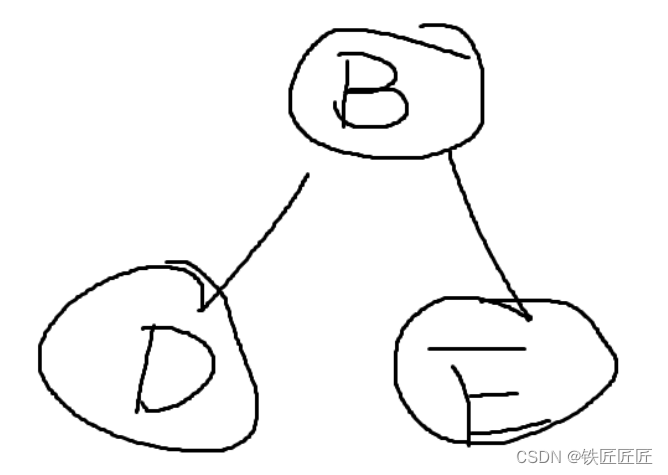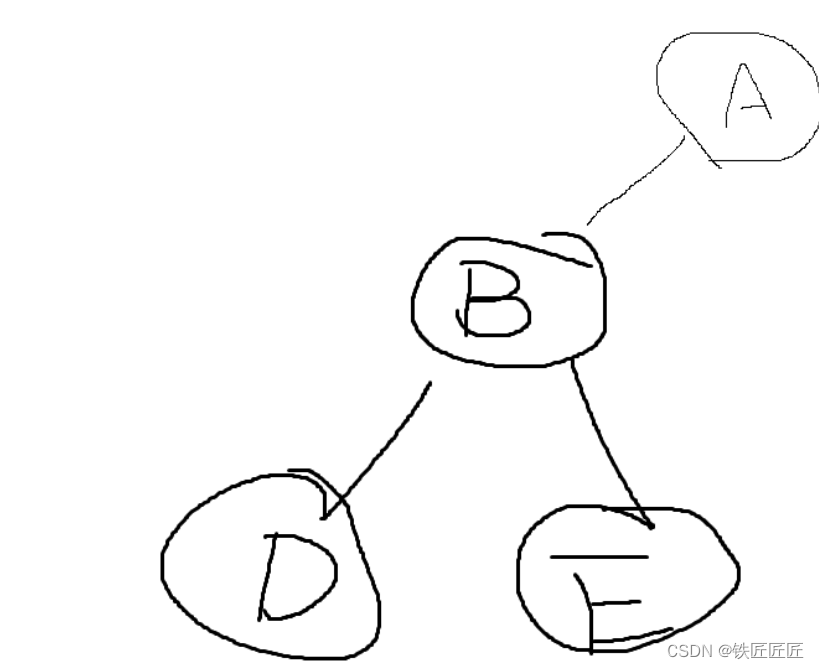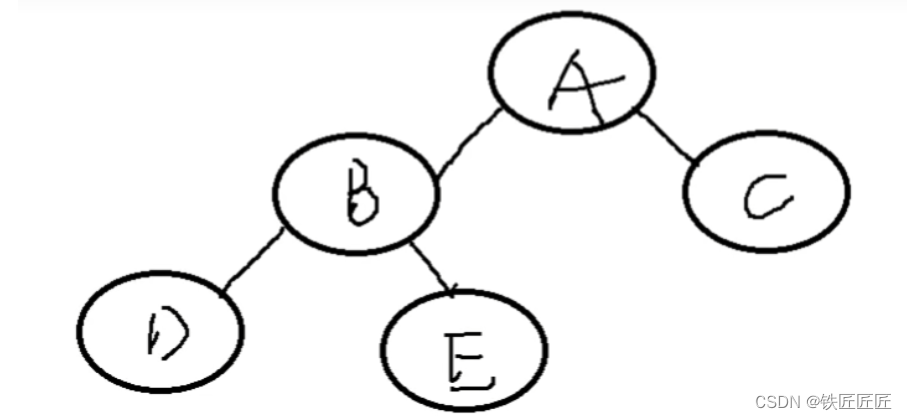文章目录
回顾查找首节点
这是我们中序线索二叉树写的
c
/* 找到最左的节点数 */
TreeNode* getFirst(TreeNode* T)
{
while (T -> ltag == 0)
T = T -> lchild;
return T;
}仔细想想,我们中序遍历这个是 左 右 中,而我们这个先序遍历是直接寻找最左边的节点,所以我们以防万一下图这种情况

如果是这种情况,我们想上述的代码是不能有效的完成工作的,所以我们需要一些简单的修改
c
/* 找到最左的节点数 */
TreeNode* getFirst(TreeNode* T)
{
while (T -> ltag == 0)
T = T -> lchild;
if(T -> rtag == 0)
getFirst(T -> rchild);
return T;
}查找下一个节点
c
TreeNode* getNext(TreeNode* node)
{
if (node -> rtag == 1)
return node -> rchild;
else
return getFirst(node -> rchild);
}我们来思考一下,原封不动的话是否可行

第一次我们带入的是D节点,程序返回的是E节点
第二次我们带入的是E节点,程序返回的是B节点
第三次我们带入的是B节点,程序返回的是E节点
后面直接就无限死循环了

答案很明显,不行
那我们要怎么修改呢,我们这个B节点应该要分多少种情况呢,可以通过推理知道,我们这个可以分为3种情况
1.是根节点。next = NULL
2.是左孩子,那么判断父亲右子树是否为空,如果右子树为空,next=parent;如果右子树不为空,next =getFirst(parent -> rchild)
3.是右孩子,next = parent
我们分别画出图来看
第一种情况:

第二种情况:


第三种情况:

那根据上图,我们应该大致看出来了,我们运行到"节点B"的时候,应该知道他的父类是多少才行,所以我们在结构上增加这个**
c
typedef struct TreeNode
{
char data;
struct TreeNode *lchild;
struct TreeNode *rchild;
struct TreeNode *parent;
int ltag;
int rtag;
}TreeNode;
c
void createTree(TreeNode** T,char* temp,int* index,TreeNode* parent)
{
char ch;
ch = temp[*index];
(*index)++;
if( ch == '#') *T = NULL;
else
{
*T =(TreeNode*)malloc(sizeof(TreeNode));
(*T)->data = ch;
(*T)->ltag = 0;
(*T)->rtag = 0;
(*T)->parent = parent;
createTree(&(*T)->lchild,temp,index,*T);
createTree(&(*T)->rchild,temp,index,*T);
}
}所以,我们根据以上三种情况,可以直接写出对应的代码
c
TreeNode* getNext(TreeNode* node)
{
if (node -> rtag == 1)
return node -> rchild;
else if(node->parent == NULL)
return NULL;
else if(node -> parent -> rchild == node)
return node -> parent;
else
{
if(node -> parent ->ltag == 0)
return getFirst(node -> parent->rchild);
else
return node -> parent;
}
}总代码
c
/*可以输入
ABD##E##CF##G##
来进行验证
*/
#include <stdio.h>
#include <stdlib.h>
#define size 20
typedef struct TreeNode
{
char data;
struct TreeNode *lchild;
struct TreeNode *rchild;
struct TreeNode *parent;
int ltag;
int rtag;
}TreeNode;
void createTree(TreeNode** T,char* temp,int* index,TreeNode* parent)
{
char ch;
ch = temp[*index];
(*index)++;
if( ch == '#') *T = NULL;
else
{
*T =(TreeNode*)malloc(sizeof(TreeNode));
(*T)->data = ch;
(*T)->ltag = 0;
(*T)->rtag = 0;
(*T)->parent = parent;
createTree(&(*T)->lchild,temp,index,*T);
createTree(&(*T)->rchild,temp,index,*T);
}
}
void inThreadTree(TreeNode* T, TreeNode** pre)
{
if(T)
{
inThreadTree(T->lchild,pre);
inThreadTree(T -> rchild, pre);
if(T->lchild == NULL)
{
T->ltag = 1;
T->lchild = *pre;
}
if(*pre != NULL && (*pre)->rchild == NULL)
{
(*pre)->rtag = 1;
(*pre)->rchild = T;
}
*pre = T;
}
}
/* 找到最左的节点数 */
TreeNode* getFirst(TreeNode* T)
{
while (T -> ltag == 0)
T = T -> lchild;
if(T->rtag == 0)
getFirst(T->rchild);
return T;
}
/* 按线索来查找 */
TreeNode* getNext(TreeNode* node)
{
if (node -> rtag == 1)
return node -> rchild;
else if(node->parent == NULL)
return NULL;
else if(node -> parent -> rchild == node)
return node -> parent;
else
{
if(node -> parent ->ltag == 0)
return getFirst(node -> parent->rchild);
else
return node -> parent;
}
}
int main(int argc, char* argv[])
{
TreeNode *T;
TreeNode* pre = NULL;
int i=0;
char *temp=NULL;
TreeNode* node = NULL;
temp=(char*)malloc(sizeof(char) * (size+1));
gets(temp);
createTree(&T,temp,&i,NULL);
inThreadTree(T, &pre);
node = getFirst(T);
for (; node != NULL; node = getNext(node)) {
printf("%c ", node -> data);
}
printf("\n");
return 0;
}
往期回顾
1.【第一章】《线性表与顺序表》
2.【第一章】《单链表》
3.【第一章】《单链表的介绍》
4.【第一章】《单链表的基本操作》
5.【第一章】《单链表循环》
6.【第一章】《双链表》
7.【第一章】《双链表循环》
8.【第二章】《栈》
9.【第二章】《队》
10.【第二章】《字符串暴力匹配》
11.【第二章】《字符串kmp匹配》
12.【第三章】《树的基础概念》
13.【第三章】《二叉树的存储结构》
14.【第三章】《二叉树链式结构及实现1》
15.【第三章】《二叉树链式结构及实现2》
16.【第三章】《二叉树链式结构及实现3》
17.【第三章】《二叉树链式结构及实现4》
18.【第三章】《二叉树链式结构及实现5》
19.【第三章】《中序线索二叉树理论部分》
20.【第三章】《中序线索二叉树代码初始化及创树》
21.【第三章】《中序线索二叉树线索化及总代码》
22【第三章】《先序线索二叉树理论及线索化》
23【第三章】《先序线索二叉树查找及总代码》
24【第三章】《后续线索二叉树线索化理论》